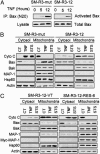MAP-1 is a mitochondrial effector of Bax
- PMID: 16199525
- PMCID: PMC1239892
- DOI: 10.1073/pnas.0503524102
MAP-1 is a mitochondrial effector of Bax
Abstract
Apoptotic stimuli induce conformational changes in Bax and trigger its translocation from cytosol to mitochondria. Upon assembling into the mitochondrial membrane, Bax initiates a death program through a series of events, culminating in the release of apoptogenic factors such as cytochrome c. Although it is known that Bax is one of the key factors for integrating multiple death signals, the mechanism by which Bax functions in mitochondria remains controversial. We have previously identified modulator of apoptosis-1 (MAP-1) as a Bax-associating protein, but its functional relationship with Bax in contributing to apoptosis regulation remains to be established. In this study, we show that MAP-1 is a critical mitochondrial effector of Bax. MAP-1 is a mitochondria-enriched protein that associates with Bax only upon apoptotic induction, which coincides with the release of cytochrome c from mitochondria. Small interfering RNAs that diminish MAP-1 levels in mammalian cell lines confer selective inhibition of Bax-mediated apoptosis. Mammalian cells with stable expression of MAP-1 small interfering RNAs are resistant to multiple apoptotic stimuli in triggering apoptotic death as well as in inducing conformation change and translocation of Bax. Similar to Bax-deficient cells, MAP-1-deficient cells exhibit aggressive anchorage-independent growth. Remarkably, recombinant Bax- or tBid-mediated release of cytochrome c from isolated mitochondria is significantly compromised in the MAP-1 knockdown cells. We propose that MAP-1 is a direct mitochondrial target of Bax.
Figures






References
-
- Wang, X. (2001) Genes Dev. 15, 2922-2933. - PubMed
-
- Green, D. R. & Reed, J. C. (1998) Science 281, 1309-1312. - PubMed
-
- Cory, S. & Adams, J. M. (2002) Nat. Rev. Cancer 2, 647-656. - PubMed
-
- Danial, N. N. & Korsmeyer, S. J. (2004) Cell 116, 205-219. - PubMed
-
- Cartron, P. F., Gallenne, T., Bougras, G., Gautier, F., Manero, F., Vusio, P., Meflah, K., Vallette, F. M. & Juin, P. (2004) Mol. Cell 16, 807-818. - PubMed
Publication types
MeSH terms
Substances
LinkOut - more resources
Full Text Sources
Other Literature Sources
Molecular Biology Databases
Research Materials

